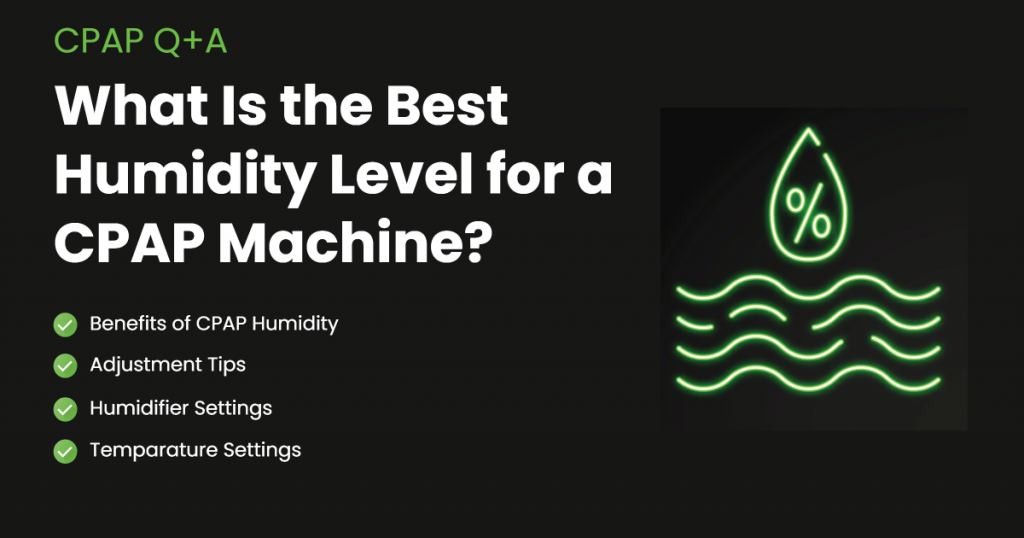
💡 Key Takeaways
- Personalized Humidity Settings: There’s no one-size-fits-all humidity level for CPAP machines; finding your ideal setting requires trial and error. Start just under half of your machine’s maximum humidity level and make small adjustments until you find what works for you.
- Seasonal Adjustments: Your humidity needs may change with the seasons, requiring less humidification in the summer and more in the winter.
- Symptom-Based Tuning: If you experience dryness or nosebleeds, consider increasing the humidity; if you notice too much moisture, reduce it.
- Don’t Overdo It: If your humidity level is too high, water can collect in your hose, gurgling or splashing onto your face and waking you up in the middle of the night. This is known as rainout.
- Heated Hose Option: For a more consistent experience, consider adding a heated hose to prevent moisture accumulation in the mask and tubing.
If you have been treating sleep apnea with CPAP for a long time, you have likely experienced adverse CPAP side effects such as mouth and nose dryness or even nose bleeds. Not only are these side effects uncomfortable to deal with, but they also make it much more difficult to stick with your therapy routine, in turn jeopardizing your health.
To combat these unwanted side effects, most modern CPAP machines now come with integrated or built-in humidifiers. The continuous, pressurized stream of air will easily dry out your nose and throat without humidification, and this happens more easily in the winter months and for those on medications with drying effects such as antihistamines, antidepressants, antipsychotics, blood pressure, and heart medications, etc. By finding the right humidity level, you can typically protect yourself from drying out your airway and developing nosebleeds.
Unfortunately, there’s no ‘best’ humidity level for your CPAP because everyone has different preferences and needs. Finding the ideal humidifier setting for your CPAP machine should only take a bit of trial and error, though, and usually only takes a handful of nights to dial in.
As a general rule of thumb, the best humidity level for CPAP machines is a setting of three. But not every CPAP machine has the same settings. This recommendation comes from machines with a maximum setting of eight. Our advice is to start at one setting below half of the maximum setting of your machine and adjust your settings up or down one at a time until you arrive at your desired humidity level. In the summer, you’ll require less humidification, but in the winter, it’s likely you’ll want a higher setting.
In this article, we’ll discuss everything you need to know about finding the best humidity level for your CPAP machine and how that changes throughout the year. Keep reading to learn how to maximize your therapy comfort with CPAP humidification!
Benefits of CPAP Humidity
There are several side effects that result from the continuous pressurized air from your CPAP machine; some of the most common are:
Mucosal Dryness
The reduction of oronasal mucus (which lines your nasal passages, throat, and the roof of your mouth) is the first sign of inadequate humidification. While the nasal passages are designed to take moisture from exhaled air and provide it for inhaled air, they can only do so with the help of mucus. Due to the constant stream of pressurized air, the mucus becomes dried out, drying out your nose, mouth, and throat in turn.
The real kicker with mucus, however, is that most people with Obstructive Sleep Apnea tend to already experience mouth and throat dryness before CPAP therapy. In fact, a study from 2010 found that 61% of the participants encountered mouth dryness before starting CPAP. Additionally, 54% reported throat dryness, 52% reported nasal stuffiness, and 51% reported nasal dryness. After the introduction of CPAP, those numbers were reduced to 37% (mouth dryness), 34% (throat dryness), 24% (nasal stuffiness), and 28% (nasal dryness) respectively. Interestingly, another study from 2017 found that even without humidification, people with chronic allergies saw an improvement in dryness when undergoing CPAP therapy.
Whether dryness improved or worsened for you after starting CPAP, the fact remains that humidification helps to return much-needed moisture to the airway and nasal passages that become dry with CPAP therapy. While some people see an improvement over their non-treated symptoms, others will still require a humidifier for more comfortable therapy.
Sinus Infections
While you might think that those treating their OSA with CPAP are more prone to developing sinus infections, research from 2012 revealed that CPAP actually reduced the number of sinus infections experienced by those with OSA. The same study establishes that most people with untreated OSA actually experience some form of adverse dryness or irritation of the respiratory tract before starting CPAP.
However, the dryness of the mucus lining in the nose and throat reduces the body’s natural protection against infections, contaminants, and allergens, so using a humidifier is a good idea to ensure your body is still able to handle and expel irritants and potential infections.
Nose Bleeds
The symptoms of dryness can aggravate the nasal passages after long stretches of dried nasal passages without humidification. By adding humidification and keeping your nasal passages from drying out, you’ll be less prone to nose bleeds from CPAP.
Sore Throat
Similar to dryness, many people with OSA actually already frequently experience sore throats before beginning CPAP. If they still have the same problem with CPAP, heated humidification provides moisture to the airway and protects it from becoming more irritated.
What Is the Best Humidity Level for CPAP?
The answer to what the humidity level should be on your CPAP machine can be different depending on the time of the year, your personal preferences and needs, and the CPAP machine being used. Thanks to the higher relative humidity in the summer, you’ll require less humidification in warmer months and less arid climates because the air is already partially humidified.
As the temperature drops in the winter, however, the air is unable to carry as much moisture and needs more help from your humidifier to maintain a comfortable therapy experience.
The majority of modern CPAP devices have built-in humidifiers, but standalone options can be found for older machines without one.
What Setting Should My CPAP Humidifier Be On?
The best humidity setting for CPAP comes down to personal requirements. Some doctors suggest turning the knob to maximum if experiencing dry mouth, nasal congestion, etc. but there are indicators to keep an eye out for to help you find the best humidity setting for your personal needs.
If you wake up feeling dry and stuffy, you’ll want to turn your humidifier up. If you run out of water, notice a lot of moisture in your mask and tubing, or wake up due to rainout, you’re likely using too much humidification or you’d benefit from introducing a heated hose to your setup, which we’ll talk about more in the section below.
As a general rule of thumb for warmer months, we recommend starting one setting below half of your machine’s maximum setting the first time you try humidification. For colder times of the year, it may be better to start at half or even one setting above half of your machine’s maximum humidity option for best results.
Keep in mind that higher pressures will require more moisture, and it’s entirely possible that a high setting of 12 cmH2O or more with maximum humidification will drain your chamber before the end of the night, depending on your CPAP machine. In other words, the maximum setting isn’t necessarily the best setting, and your results will vary depending on the variables we’ve discussed.
What Temperature Should I Set My CPAP Humidifier?
When it comes to CPAP humidification, temperature is an interesting topic. If there is water in your chamber but the humidifier is turned off, the air will still pass through the chamber, collecting a small amount of moisture on the way. This is called passover humidification, and it is typically more effective in warmer climates with already-high relative humidity.
When enabled, the settings on your humidifier provide more humidification by raising the temperature of the heating plate located beneath your water chamber. While you won’t be able to set your temperature and humidity level independently, a heated hose can help reduce the collection of excess condensation and moisture in your mask and hose.
When the air outside your hose is colder than the air inside of it, condensation forms and water gathers in the tube and mask. Not only can this splash onto your face and wake you up in the middle of the night, but it’s also a breeding ground for bacteria when not properly dried in the morning.
Heated hoses will maintain a consistent tube temperature, preventing you from losing moisture to the temperature difference and in turn, running your CPAP machine and humidifier more efficiently. Insulated hose covers can also accomplish this task, but won’t be as consistent as heated tubing.
FAQs
What Happens if Your CPAP Humidity Is Too High?
If your CPAP humidity is too high, you’ll notice an accumulation of moisture in your mask and hose. This collection of moisture might even collect to the point that it eventually splashes onto your face and wakes you up in a phenomenon known as rainout. Heated or insulated hoses can help prevent rainout and provide more consistent humidification.
When Should I Increase the Humidity in My CPAP?
You should increase the humidity in your CPAP if you are still waking up with a dry mouth, throat, or nose, or experiencing nose bleeds after CPAP. If you wear a nasal mask and use humidification already, a CPAP chinstrap may help you combat dry mouth symptoms.
What Does the Humidity Level Mean on My CPAP Machine?
Humidity levels on the CPAP refer to the amount of moisture in the air provided by your CPAP machine. Heated humidification can help relieve common CPAP side effects such as dry mouth, dry throat, dry nose, and nosebleeds.
What Humidity Level Should I Set My CPAP At?
As a general rule of thumb, we recommend setting your CPAP machine to one setting below half of your maximum humidity setting and adjusting up or down one setting at a time until you find a reduction in your symptoms or stop the accumulation of water in your mask and hose.
Conclusion
CPAP humidification is a highly personal experience that some people hate and some people can’t live without. While the perfect humidity setting may bring relief to one person in one climate, the same setting could lead to rainout for someone else in a colder climate.
When setting your humidifier, we recommend setting the humidity level to one setting below half of your machine’s maximum humidification option. From there, change your humidity one level up or down at a time to find the best setting for your needs. If you’re still waking up dry and scratchy, turn it up. If you’re waking up to rainout or noticing too much moisture in your mask in the morning, try turning the humidification down or adding a heated hose for a more consistent experience.
We hope this article helped you better understand your CPAP machine’s humidifier settings. If you liked the article, drop a comment below and tell us how you set your humidifier! If you’re still struggling to find the right setting, reach out to our expert customer service agents at 1-800-356-5221 from 8 a.m. to 8 p.m. Monday through Friday or 8 a.m. to 5 p.m. on Saturday and Sunday, and they’ll be more than happy to assist you!




